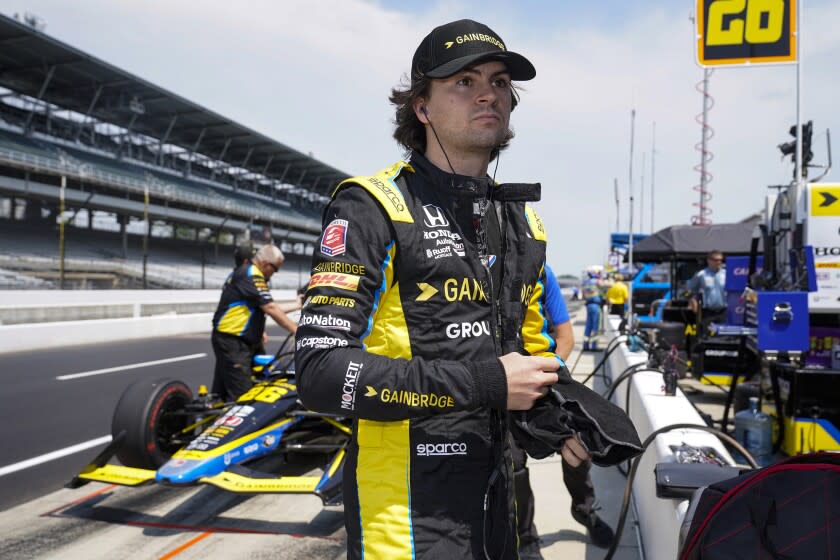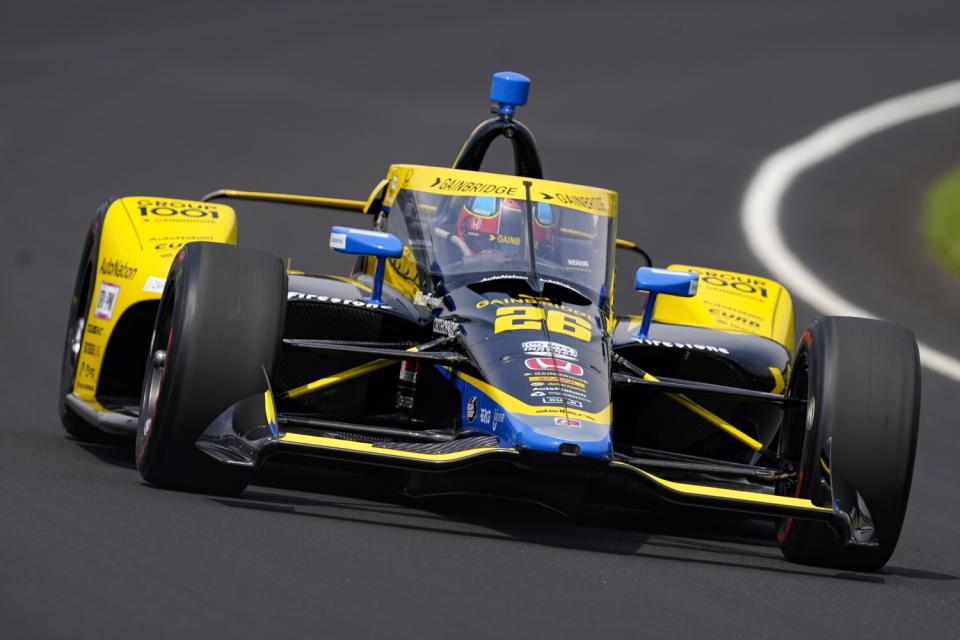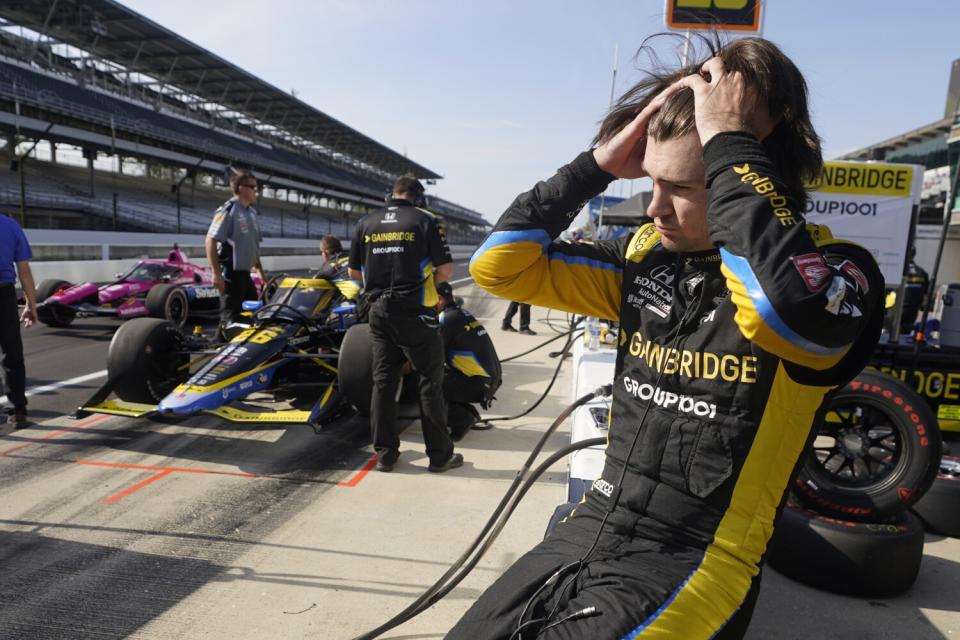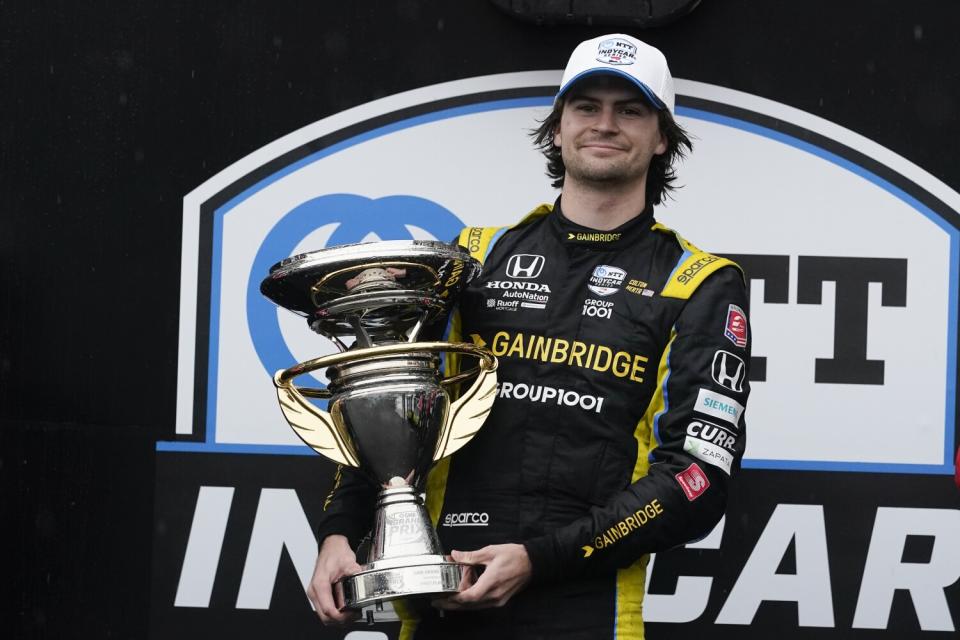Valencia's Colton Herta willing to take risks for Indianapolis 500 victory
- Oops!Something went wrong.Please try again later.
- Oops!Something went wrong.Please try again later.

A month after the crash, Colton Herta’s voice doesn’t waver when talking about it.
It was supposed to be his race. The tight corners, the curves of downtown Long Beach were so familiar. At 2 weeks old, he heard the roar of engines for the first time there, nap time interrupted as he watched his dad, Bryan, wheel around the streets.
The younger Herta climbed to the winner’s step of the Grand Prix of Long Beach podium in 2021 at age 21, and he had dominated this year's contest through 55 laps. But on the 56th, he lost control.
“Just kind of felt I let down a lot of people,” Herta said.
Careening into a turn, the chassis of his No. 26 Andretti Autosport Honda hit the asphalt. The car locked up. A fork in the road loomed: Try to hold on long enough to squeeze past the corner, or bail into the runoff and reset.
He just might make the corner, he thought. So he stayed.
But the car wouldn’t straighten, and the wall crept closer. In a split second, Herta knew.
It was too late.
"Oh, s—," he thought, before the front-left bumper slammed into the barrier.
A month later, Herta was nonchalant about the April wipeout. In the moment, he tugged helplessly at the rim of his helmet, his car still sputtering on the asphalt. It was disappointing. Heartbreaking. But when you’re young and fearless, mistakes happen.
Another one happened Friday, when Herta’s car flipped and skidded across the asphalt during practice at Indianapolis Motor Speedway. It was a potentially devastating crash — but Herta, true to form, shrugged it off in a tweet, adding a fist-bump emoji to a short message about moving to the team’s backup car for Sunday's Indianapolis 500. He was cleared to drive Saturday.
“It’s nice, that feeling of getting back in the race car,” said Herta, a native of Valencia. “I always felt like that was a strong suit of mine, of being able to push that to the side and focus forward on what the next thing is.”
Longtime engineer Nathan O’Rourke said Herta's team encourages him to be aggressive.
“He’s going to be able to handle that risk … he’s able to do things with the car that most drivers can’t,” O’Rourke said.

Bill Auberlen is the winningest driver in IMSA SportsCar Championship history. And even he has no idea how Herta does it.
“He’s small, and he’s frail, and he’s tiny,” Auberlen said before the Long Beach Grand Prix. “You think, ‘How’s this guy going turn the steering wheel?’”
But Herta is “super fast,” according to driver Alex Palou, last year’s IndyCar champ. And he’s not afraid to be.
Auberlen is close friends with Bryan Herta, a former teammate in sports cars. After teaming up with Colton at the 2021 Rolex 24 at Daytona, the IMSA legend immediately called Bryan.
“‘That’s probably the best race car driver I’ve ever seen in my entire life,’” Auberlen told him.
Herta was known as his father’s son growing up, he said. Bryan Herta raced both sports cars and Indy cars in a career that spanned 16 years, notching four open-wheel wins.
In modern times, though, Bryan is his son’s father. Colton put himself on the map with his first IndyCar win at Circuit of the Americas in Austin in 2019 — at age 18, the youngest in IndyCar history.
“I knew I had to fight and prove that I belonged there and earn the respect of everybody, especially the veterans,” Herta said. “But I never felt intimidated getting into the car.”
In due time, Herta might give a new set of veterans a run for their money. Tabbed to test drive Formula 1’s 2021 McLaren car later this year, there’s an ever-growing buzz that he might fill a spot for an American driver.
“I even told Colton, ‘If any American gets the opportunity to go to Formula 1, it’s got to be you,” Auberlen said.
His fellow IndyCar drivers endorse the idea — even Pato O’Ward, a rival young series star who’s hoping for a shot himself. Racing in F1 as an American, Herta would be a fish out of water. But it’s always been a dream of his.
“It’s a challenge that I’m up for,” he said.

He knew he had to take a risk.
After two consecutive top-five finishes in the IndyCar standings, Herta’s fifth year in the series was off to a disappointing start. He was mired in the middle of the rankings, and the Acura Grand Prix was his chance to climb back. But after the wall scattered part of his car's front wing into specks of stardust across the Long Beach asphalt, Herta was eliminated.
“Just overdid it a little bit today,” he said in a television interview.
It was déjà vu. Herta used that exact same phrase — “overdid it” — after a devastating wreck last year in Nashville. In that race, on Lap 75, Herta crashed and didn’t finish while trying to catch winner Marcus Ericsson. He was in second place at the time.
“Especially at the highest level, still pretty early on in my career, still constantly learning a bunch,” Herta said.
Learning. But not being scared to fail. Herta and his team knew, heading into the GMR Grand Prix on May 14, that they had to start winning races. A poor qualifying run, placing him 14th to start, only made his situation more dire.
As the cloud-blanketed sun began to set on a gray afternoon, sheets of Indiana rain slicked the track at the Indianapolis Motor Speedway. Most cars pressed on with their Firestone rain tires, mandated for the start.
Not Herta.
“I knew we had to be aggressive,” Herta said.
On the third lap, Herta and his father made the decision to pit and swap out rain tires for dry, thinking they could gain ground to jump a few positions. He jumped, in fact, to the front.

But around a bend, as his tires dug for traction on a wet surface, Herta began drifting toward the grass bordering the track.
In the month since, he’s experienced flashbacks from Long Beach behind the wheel. If his grip had been better — if his car was angled six inches farther — perhaps he never hits the wall. Perhaps he’s named a back-to-back winner. But it happened, and position, Herta’s learned, is everything.
So, yards away from a burnout, his fast hands took hold. He spun the wheel fully around to the left, sending the car into a drift lasting seconds but feeling like minutes, skidding forward with the nose pointing in the wrong direction and miraculously whipping back into place.
“Some guys might not have been able to handle that,” O’Rourke said. “But honestly, most guys wouldn’t have pushed that hard, either.”
Amid buckets of rain, Herta went on to beat the field to earn his first win of the season.
“It seemed 50-50 to me on whether it was the right call or not,” Herta said of the early tire switch. “It ended up being a very good call.”
His next challenge looms Sunday, the Indianapolis 500 the most important race of the year. After engine trouble in qualifying, Herta will start 25th, leaving him with ground to make up.
That may mean only one thing — more aggressive moves. And Herta and his team won’t shy away from it.
“That might end up in a crash, but it’s definitely more worth the risk to do those types of moves,” O’Rourke said. “I think that’s going to be his approach.”
This story originally appeared in Los Angeles Times.

